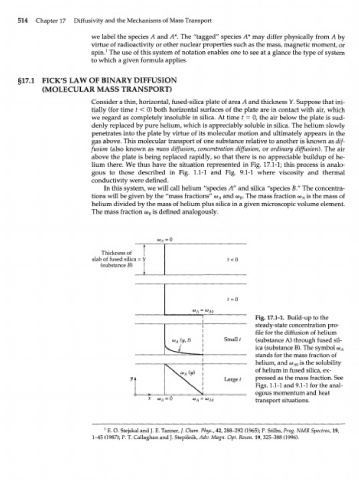Page 534 - Bird R.B. Transport phenomena
P. 534
514 Chapter 17 Diffusivity and the Mechanisms of Mass Transport
we label the species A and A*. The "tagged" species A* may differ physically from A by
virtue of radioactivity or other nuclear properties such as the mass, magnetic moment, or
spin. 1 The use of this system of notation enables one to see at a glance the type of system
to which a given formula applies.
§17.1 PICK'S LAW OF BINARY DIFFUSION
(MOLECULAR MASS TRANSPORT)
Consider a thin, horizontal, fused-silica plate of area A and thickness У. Suppose that ini-
tially (for time t < 0) both horizontal surfaces of the plate are in contact with air, which
we regard as completely insoluble in silica. At time t = 0, the air below the plate is sud-
denly replaced by pure helium, which is appreciably soluble in silica. The helium slowly
penetrates into the plate by virtue of its molecular motion and ultimately appears in the
gas above. This molecular transport of one substance relative to another is known as dif-
fusion (also known as mass diffusion, concentration diffusion, or ordinary diffusion). The air
above the plate is being replaced rapidly, so that there is no appreciable buildup of he-
lium there. We thus have the situation represented in Fig. 17.1-1; this process is analo-
gous to those described in Fig. 1.1-1 and Fig. 9.1-1 where viscosity and thermal
conductivity were defined.
In this system, we will call helium "species A" and silica "species B." The concentra-
tions will be given by the "mass fractions" co and co . The mass fraction co is the mass of
A
B
A
helium divided by the mass of helium plus silica in a given microscopic volume element.
The mass fraction a) is defined analogously.
B
Thickness of
slab of fused silica = У t<0
(substance B)
<°A0
Fig. 17.1-1. Build-up to the
steady-state concentration pro-
file for the diffusion of helium
0) (у, 0 Small t (substance A) through fused sil-
A
ica (substance B). The symbol co A
stands for the mass fraction of
helium, and co is the solubility
A0
of helium in fused silica, ex-
Large t pressed as the mass fraction. See
Figs. 1.1-1 and 9.1-1 for the anal-
ogous momentum and heat
x transport situations.
«>A = 0
1 E. O. Stejskal and J. E. Tanner, /. Chem. Phys., 42, 288-292 (1965); P. Stilbs, Prog. NMR Spectros, 19,
1-45 (1987); P. T. Callaghan and J. Stepisnik, Adv. Magn. Opt. Reson. 19, 325-388 (1996).

